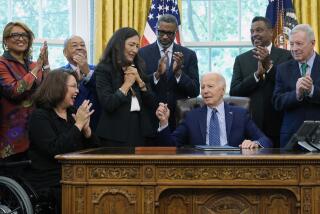A Civil War That Remains Unsettled : Urban history: The bloody 1863 uprising known as the New York draft riots still echoes with lessons for our cities.
- Share via
One hundred and thirty-one years ago this summer, two battles took place that had immense implications for America’s future. The first, at Gettysburg, marked the beginning of the end for the Southern secessionists and for slavery, the social institution at the center of their cause.
The second began 10 days later, on July 13, in New York City. It was sparked by the imposition of a military draft and the provision that allowed a draftee to buy his way out for $300--the equivalent of a workingman’s annual wage. The several days that followed of street fighting, arson and murder remain the deadliest and most destructive riot in American history. This year, as in former ones, the conflict at Gettysburg was re-enacted by Civil War buffs. About the other battle, the one that took place in New York, little will be said. There will be no military pantomimes, no cannons in the streets, no enthusiasts dressed as immigrant laborers firing from rooftops at police and soldiers, no simulated mobs hunting down victims, no pretended looting of homes and businesses or burning of orphanages.
Except among professional historians, knowledge about the draft riots is scant. Few recall that the protagonists of the country’s worst riot were white and Irish, part of the massive influx that flooded America’s cities in the wake of the famine that devastated Ireland little more than a decade before.
Impoverished, unskilled, reviled by the Anglo-Saxon Protestant upper classes and riddled with all the social pathologies that are still commonly associated with the poor, the Irish added to the innate distrust Americans have always had for their cities. Indeed, the numbers, behavior and supposedly ineradicable foreignness of the Irish caused many observers to despair over the fate of New York. “The town is taken by its rats,” Herman Melville wrote after the riots, “shiprats and rats of the wharves.”
The faces of the urban poor have changed since 1863. After a protracted period of struggle and assimilation, the descendants of the Irish are no longer poor, oppressed or even largely urban. But the labels once hung on them--”ignorant,” “lazy,” “uneducable,” “violent,” “disease infested”--continue to be applied to those who have taken their place.
In truth, unlike Gettysburg, we have no need to memorialize that week of bloodshed in New York. The draft riots are within our experience, part of the Civil War that didn’t end at Appomattox but rages to this day. We’ve seen their ghastly images of racial hatred, ethnic conflict and mob violence mirrored in our time, most recently in the conflicts that wracked Brooklyn’s Crown Heights and overwhelmed Los Angeles.
Our cities remain places where different races and immigrant groups claw at one another to pull their way out of poverty. The issue of race, so brutally reflected during the draft riots by mobs that assaulted and murdered African Americans, is still central and inescapable.
In many ways, our cities are closer to what they were in the 1860s than in the 1940s or 1950s. Home to large populations of people who feel isolated and hopeless, they struggle with problems of crime, health, public squalor, with worn, inadequate infrastructure and inferior schools. And if no one can be sure when and in which city the next battle will erupt, unless we begin to find answers to these problems, who doubts that it will?
The War Between the States is over. Its battlefields are green and quiet. But the war in our cities goes on. Here, amid the tensions and rivalries, the question posed by Lincoln on the hallowed ground of Gettysburg--whether a nation such as ours “or any nation so conceived and so dedicated can long endure”--is alive and unanswered.
More to Read
Sign up for Essential California
The most important California stories and recommendations in your inbox every morning.
You may occasionally receive promotional content from the Los Angeles Times.













